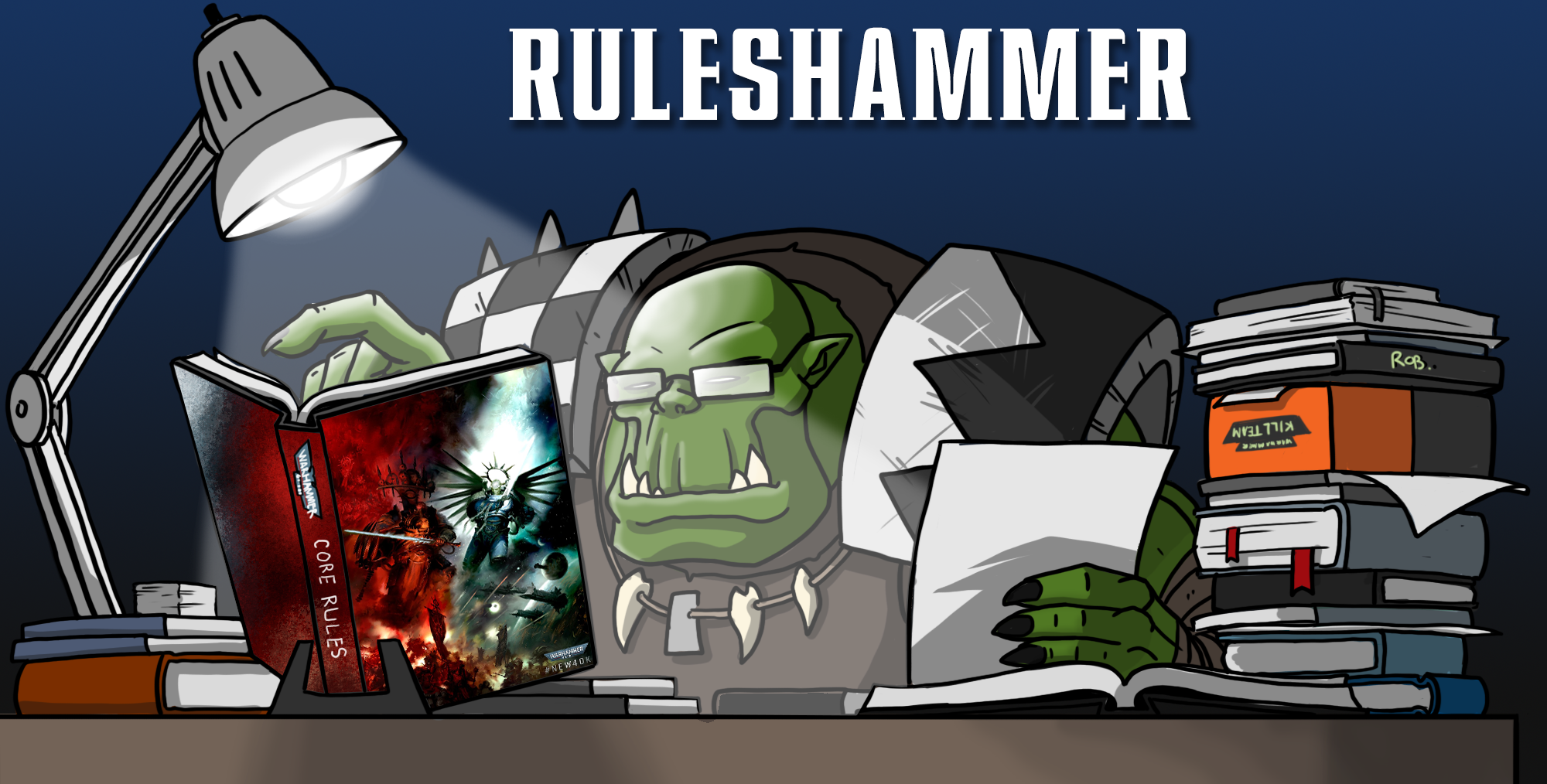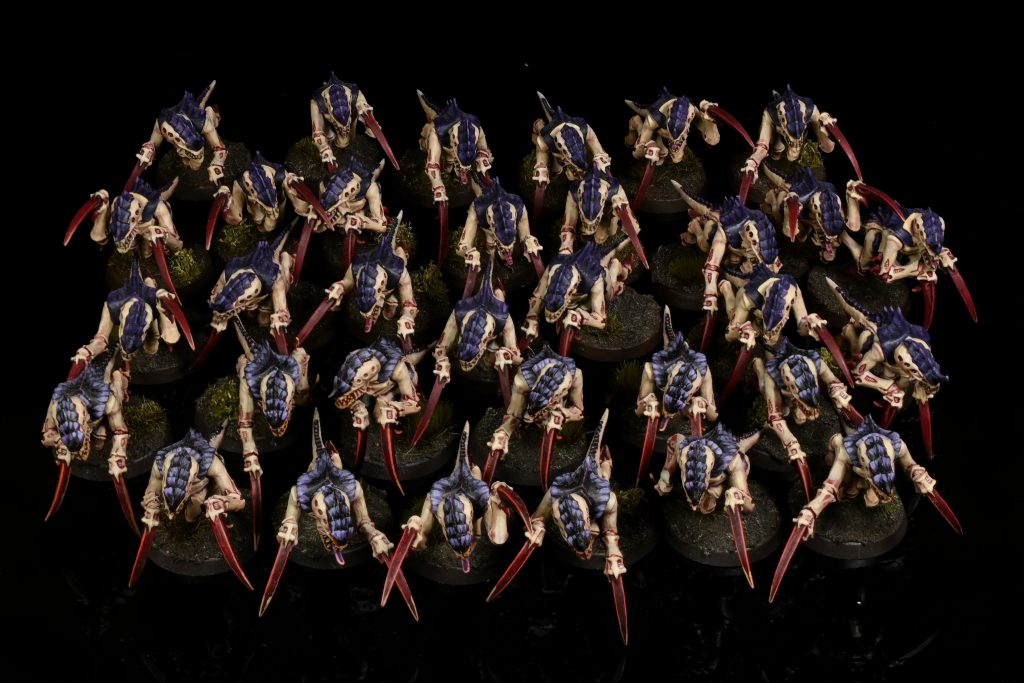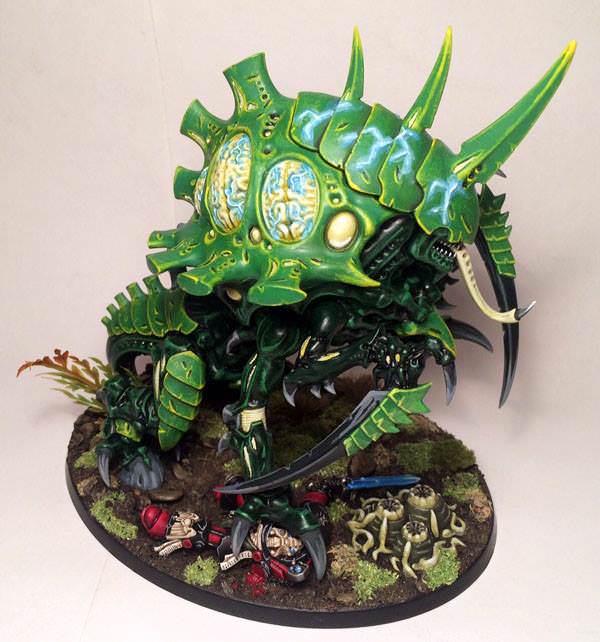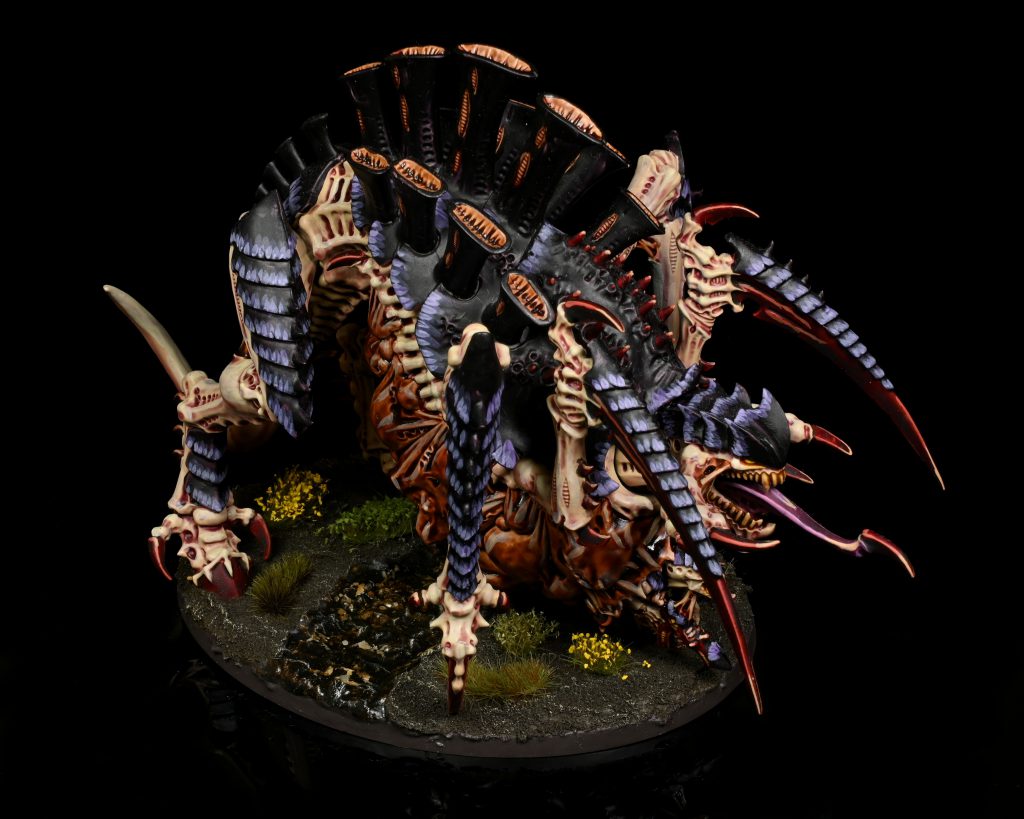Welcome to Ruleshammer! My ongoing attempt to make sense of the many rules, abilities and interactions of both in games of Warhammer 40k. You can find more Ruleshammer Q&A by clicking the banner below!
Table of Contents
Q&A
The Overrun Stratagem is when?
The Overrunn Stratagem has a slight timing issue.
Use this Stratagem at the end of the Fight phase. Select one HIVE TENDRIL unit from your army that made a charge move this turn. If there are no enemy models within Engagement Range of that unit, models in that unit can make a Normal Move instead of making a consolidation move.
The problem here is timing: Using this stratagem at the end of the fight phase means using it after all the units have already made their consolidation moves. I’m not even really sure what to suggest as it seems the idea of this change is to give the opposing player time to react by giving them an opportunity to pile in and fight before the unit makes its normal move – it’s worth noting that the Stratagem’s previous wording had a player use the Stratagem after destroying an enemy unit. It might need an entire re-write.
Pre FAQ Suggestion: This stratagem doesn’t work as written. Like I can’t figure out a wording that isn’t a downgrade or inadvertently better. It really needs an FAQ to be sure about what GW were trying to change. I’d almost suggest using the 8th edition version until this one is clarified.

Seeding Spore Nodes without actually seeding spore nodes.
A few keen-eyed Tyranids players I know have spotted a slight issue with this secondary.
SPORE NODES
Score 4 victory points each time a unit from your army successfully completes the following action:
Seed Spore Node (Action): One Troops unit from your army can start to perform this action at the end of your Movement phase from the second battle round onwards if it is within 6″ of your opponent’s deployment zone and not within 6″ of any Spore Node objective markers. The action is completed at the end of your turn. If this action is successfully completed, place one objective marker anywhere wholly within your opponent’s deployment zone and within 1″ of the unit that completed this action. This objective marker represents a Spore Node, but does not count as an objective marker for any rules purposes other than for this secondary objective.
The criteria for completing this action are that the unit is within 6″ of the enemy deployment zone and not within 6″ of any Spore Node markers. However it is possible for a unit to be both within 6″ of the enemy deployment zone but more than 1″ away from the deployment zone, meaning that it won’t be possible to place a spore node within 1″ of the unit doing the action and within the enemy deployment upon completion of the action. This doesn’t cause the action to fail, though as being able to place the Spore Node is not a condition of completing the action. It probably should be.
Pre FAQ Suggestion: Change the highlighted sentences to:
At the end of your turn, attempt to place on Spore Node Marker. This action is completed at the end of your turn if a Spore Node Objective marker has been placed. When placing Spore Node objective markers they must be wholly within the enemy deployment zone and within 1″ of the unit attempting the action, if this is not possible then no marker is placed and the action fails to complete.
Swarming Masses and targeting?
Tyranids have a new rule that is meant to give the army the ability to have more bodies in a fight, however it does have a small Rules-as-Written (RAW) issue.
SWARMING MASSES
Each time this unit fights, models in this unit can fight if:
– They are within Engagement Range of any enemy units.
– They are within 2½” of any enemy units.
If, in the Fight phase, this unit is subject to any other rules that would reduce the number of models from this unit that are able to fight, then neither those rules nor the Swarming Masses rule take effect for that phase.
First of all, this rule doesn’t allow all units within 2½” to fight; they have to be eligible to fight normally, either by having charged or having an enemy unit within Engagement Range. This is established by the fact that this rule is trigger “Each time this unit Fights.”
Second, it misses out an important part required to make the 2½” part function as intended: To Fight in Warhammer 40k 9th edition is to Pile In, Make Close Combat Attacks, and Consolidate. Something the whole unit can do regardless of range to enemy models if the unit is eligible to fight. This doesn’t however alter the rules for choosing targets. Essentially GW are using the word Fight too often and I think they got confused.
Which Models Fight
When a unit makes close combat attacks, only the models in that unit that are either within Engagement Range of an enemy unit, or that are within ½” of another model from their own unit that is itself within ½” of an enemy unit, can fight.
GW, the unit is already fighting! That was already established. Because they keep using the word “Fight” they have missed out the clearly intended ability to be able to select targets with these models.
Select Targets
Before you resolve any attacks, you must first select the target unit(s) for all of the attacks. Attacks made by models in units that made a charge move this turn can only target enemy units that their unit declared a charge against, or that performed a Heroic Intervention this turn. In order to target an enemy unit, an attacking model must either be within Engagement Range of that unit, or within ½” of another model in its own unit that is itself within ½” of that enemy unit.
something that other rules have covered such as Defence Line.
Defence Line
If an enemy unit is within 1″ of this terrain feature, you can still make a charge move against it so long as the charging unit ends its charge move touching that terrain feature and within 2″ of the target unit. Units are eligible to fight, and models can make attacks with melee weapons, if their target is on the opposite side of this terrain feature and within 2″.
This one might not get an FAQ because it’s probably too pedantic, I think it’s meant to be something like.
Pre FAQ Suggestion: When a unit with Swarming Masses fights, models in that unit can target enemy units they are within 2½” of that at least one model from their unit is within Engagement Range of.
Harpies and Territorial Instincts
I think I might disappoint a few Harpies with this one but I’m pretty sure even with Objective Secured a Harpy can’t contribute to control of an object. While the ability does give the model Obsec,
Territorial Instincts
– MONSTER models with this adaptation have the Objective Secured ability.
…
The Objective rules are pretty clear on the fact that AIRCRAFT models should be excluded when determining objective control.
AIRCRAFT units and units with the Fortifications Battlefield Role can never control objective markers – exclude these units when determining which player controls an objective marker.
and if you’re excluding them for determining objective control then they are not included in the check for models on that objective with Objective Secured, as that is part of determining control of an objective marker.
OBJECTIVE SECURED
Some units have an ability called Objective Secured. A player controls an objective marker if they have any models with this ability within range of that objective marker, even if there are more enemy models within range of that objective marker. If an enemy model within range of an objective marker also has this ability (or a similar ability), then the objective marker is controlled by the player who has the most models within range of that objective marker as normal.
And nothing in the Obsec rule overrides that.
Spore Mines and Enemy Reinforcement Units
This one is interesting: A reinforcement unit when it arrives has “moved” but has it ended a move? For those unware, every unit coming in from Reinforcements can come in right next to a spore mine.
Each time an enemy unit is set up on the battlefield, this unit, and any models within it, are ignored for the purposes of any rules specifying where that enemy unit can be set up.
As written it might even be argued that it ignores the rule against setting up units within Engagement Range. Thought that’s a pretty odd thing to want to do when we are talking about living bombs. The next relevant part of the rule is what triggers that explosion.
Floating Death: Each time a model in this unit ends a move within 3″ of any enemy units, or an enemy unit ends a move during which any of its models moved within 3″ of a model from this unit, that model can explode.
So it comes down to if setting up a unit counts as “ending a move”.
Reinforcement units cannot make a Normal Move, Advance, Fall Back or Remain Stationary in the turn they arrive for any reason, but they can otherwise act normally (shoot, charge, fight etc.). Models in units that arrived as Reinforcements count as having moved a distance in inches equal to their Move (M) characteristic in this Movement phase.
While it’s very clear it counts as moving, the “end a move” bit is a bit more ambiguous. I think I’m incline to say it does count as ending a move, mostly because it seems odd that this small nuance would cause Spore Mines to not explode. I’m not sure what tactical advantage if any there might be in purposefully making them explode though.
What counts as Manifesting for Maleceptor’s Psychic Overload?
Q: What does it mean to “successfully manifest a psychic power” for the purposes of the Maleceptor’s Psychic Overload Ability? The rules for manifesting powers appear to suggest that successfully manifesting means overcoming the opponent’s deny the witch roll. But what if your opponent uses a Stratagem to cancel your power, either after failing a deny the witch attempt, or instead of doing so? – Chris G
I don’t think there’s anything too mysterious about this interaction.
So long as the Psychic test was successful and the psychic power was not denied by a successful Deny the Witch test, the psychic power is successfully manifested and its effects, which will be described in the power itself, are then resolved.
A manifested power is one that passed the test and was not denied. I can’t seem to find any examples of powers that deny without using the Deny The Witch test (or a modified version of it), though. I could be wrong but I think they all work the same way.
Update
Since writing this someone did point out that the Souls of Iron ability sort of doesn’t deny and would potentially be the middle ground suspected to exist.
Use this Stratagem in your opponent’s Psychic phase, when an enemy PSYKER model manifests a psychic power within 24″ of an IRON HANDS unit from your army (after any Deny the Witch attempt). Roll one D6; on a 4+ that psychic power is resisted.
However “resisted” isn’t a term that is really defined in 9th edition. It certainly means that the effect of the power doesn’t occur. Though as this stratagem is literally used when a power is manifested I think that would mean that the Maleceptor ability is triggered rules as written. Meaning while the power doesn’t do anything the mortals to the nearest unit would happen still. Rules as Intended though there’s a number of rules where “resisted” is an 8e term that should be interpreted as equal to denied, and that the timing of this stratagem is just using old terminology. Empyric Severance for instance in 9e say:
Use this Stratagem in your opponent’s Psychic phase, after a Psychic test is passed for an enemy PSYKER unit and after any Deny the Witch attempt is made (if any). If that enemy PSYKER unit is within 18″ of any ANATHEMA PSYKANA INFANTRY units from your army, roll one D6: on a 4+, that psychic power is denied.
rather than it’s 8e timing
Use this Stratagem in your opponent’s Psychic phase, when an enemy PSYKER manifests a psychic power within 18″ of a SISTERS OF SILENCE INFANTRY unit from your army, after any Deny the Witch attempt. Roll one D6; on a 3+ that psychic power is resisted and its effects are negated.
the new version is before Manifesting. This won’t be FAQed, because Iron Hands is old.
Pre FAQ Suggestion: If a psychic power is prevented in any way, I suggest that that also prevents the Maleceptor ability from triggering.
Tervigon-spawned units and Biomorphologies
Q: Do the units spawns by a Tervigon gain the Biomorphology of the army when spawned?
No. The Hive Fleet Adaption abilities are given to units in <HIVE FLEET> Detachments.
If your army is Battle-forged, <HIVE FLEET> units in HIVE TENDRIL Detachments gain access to the following hive fleet rules, provided every <HIVE FLEET> unit in your army is from the same hive fleet. If every <HIVE FLEET> unit in a HIVE TENDRIL Detachment is from the same hive fleet, that Detachment is referred to as a Hive Fleet Detachment.
Hive Fleet Adaptions being one of the hive fleet rules provided. A spawned or summoned unit is a unit added to your army but it is not in any detachments and does not gain those rules. It does share the <HIVE FLEET> of the spawning mother Tervigon though, so any abilities requiring that shared Keyword such as powers, auras, or stratagems do work on the spawned units.
How many times can I use Encircle the Prey?
So this stratagem avoids the usual limit of once per turn by not being used within a phase.
Use this Stratagem at the end of your turn. Select one BURROWERS unit or unit that can FLY from your army. Remove that unit from the battlefield. In the Reinforcements step of your next Movement phase, you can set that unit back up anywhere on the battlefield anywhere that is more than 9″ away from any enemy models. If the battle ends and that unit is not on the battlefield, it is destroyed. A unit cannot be selected for this Stratagem if it was set up on the battlefield this turn.
which as the end of your turn isn’t in a phase, falls into the exclusion the stratagem rules lay out.
…but you cannot use the same Stratagem more than once in the same phase (for the purposes of this rule, Stratagems that have identical names, but that appear in different publications, are still considered to be the same Stratagem). This does not affect Stratagems that are not used during a phase, such as those used ‘before the battle’ or ‘at the end of the battle round.
Which is probably pretty strong for an army built around making use of it. I’m honestly not sure if it’s intended to avoid the limit on stratagem use or not but as it’s technically broken or ambiguous I don’t think over suggesting a change to this before an FAQ is necessary.
Have any questions or feedback? Got a rules question you want answered? Drop us a note in the comments below, ask a question in our Ruleshammer form, or head over to r/ruleshammer to discuss.






